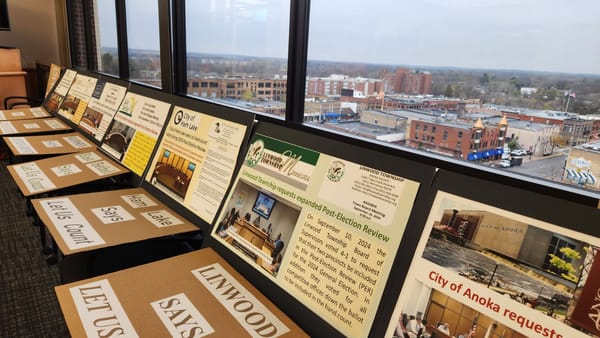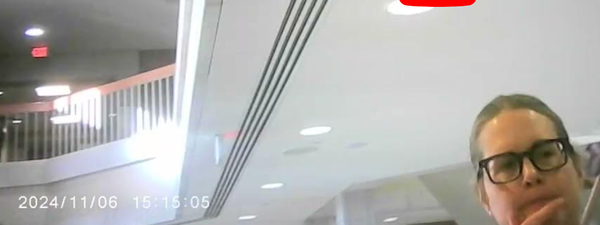Minnesota Voting Rights Act
"Protected class" means a class of citizens who are members of a racial, color, or language minority group, or who are members of a federally recognized Indian Tribe, including a class of two or more such groups.

This is a head-scratcher...
from HF4772 and SF4729
Sec. 3.
[200.50] MINNESOTA VOTING RIGHTS ACT.
Sections 200.50 to 200.59 may be cited as the "Minnesota Voting Rights Act."
EFFECTIVE DATE.
This section is effective the day following final enactment.
Sec. 4.
[200.52] DEFINITIONS.
Subdivision 1.
Application.
As used in sections 200.50 to 200.59, the terms as defined
in this section have the meanings given.
Subd. 2.
Government official.
"Government official" means any individual who is
elected or appointed to an office in this state or a political subdivision or who is authorized
to act in an official capacity on behalf of the state or a political subdivision.
Subd. 3.
Language minority group.
"Language minority group" means a language
minority group as that term is defined in the federal Voting Rights Act of 1965, as amended,
as of the effective date of this act.
Subd. 4.
Method of election.
(a) "Method of election" means the method by which
candidates are elected to the legislative body of a political subdivision, and includes at-large
method of election, district-based method of election, or any alternative method of election.
Method of election also includes the districting or redistricting plan used to elect candidates
to the legislative body of a political subdivision.
(b) "At-large method of election" means a method of electing candidates to the legislative
body of a political subdivision in which candidates are voted on by all voters of the political
subdivision or that combines at-large with district-based methods of elections. At-large
method of election does not include any alternative method of election.
(c) "District-based method of election" means a method of electing candidates to the
legislative body of a political subdivision in which, for political subdivisions divided into
districts, a candidate for any district is required to reside in the district and candidates
representing or seeking to represent the district are voted on by only the voters who reside
in the district. District-based method of election does not include any alternative method of
election.
(d) "Alternative method of election" means a method of electing candidates to the
legislative body of a political subdivision other than an at-large method of election or a
district-based method of election and includes but is not limited to cumulative voting, limited
voting, and proportional ranked choice voting.
Subd. 5.
Political subdivision.
"Political subdivision" means a county, city, town, or
school district.
Subd. 6.
Politically cohesive.
"Politically cohesive" means that members of a group
tend to prefer the same candidates, electoral choices, or policies.
Subd. 7.
Protected class.
"Protected class" means a class of citizens who are members
of a racial, color, or language minority group, or who are members of a federally recognized
Indian Tribe, including a class of two or more such groups.
Subd. 8.
Polarized voting.
"Polarized voting" means voting in which the candidate or
electoral choice preferred by a protected class diverges from the candidate or electoral choice
preferred by other voters.
Subd. 9.
Vote; voting.
"Vote" or "voting" includes any action necessary to cast a ballot
and make that ballot count in any election, including but not limited to: registering to vote;
applying for an absentee ballot; and any other action required by law as a prerequisite to
casting a ballot and having that ballot counted, canvassed, certified, and included in the
appropriate totals of votes cast with respect to an election.
Subd. 10.
Voting eligible population.
"Voting eligible population" means those
individuals who are eligible to register and vote, regardless of whether the individuals are
registered to vote.
EFFECTIVE DATE.
This section is effective the day following final enactment.
Sec. 5.
[200.53] CONSTRUCTION AND USE OF AUTHORITY.
A law, rule, local law, charter provision, local ordinance, or local code relating to the
right to vote, or which grants authority to prescribe or maintain voting or elections policies
and practices, must be construed or applied liberally in favor of a voter's exercise of the
right of suffrage. To the extent a court is afforded discretion on an issue, including but not
limited to discovery, procedure, admissibility of evidence, or remedies, the court must
exercise that discretion and weigh other equitable discretion in favor of this right.
EFFECTIVE DATE.
This section is effective the day following final enactment.
Sec. 6.
[200.54] VOTER SUPPRESSION AND VOTE DILUTION PROHIBITED.
Subdivision 1.
Voter suppression.
A political subdivision or any other government
official or entity responsible for election administration must not adopt or apply a
qualification for eligibility to vote or other prerequisite to voting; adopt or apply any law,
ordinance, rule, standard, practice, procedure, or policy regarding the administration of
elections; or take any other action or fail to take any action that results in, is likely to result
in, or is intended to result in a denial or abridgement of the right to vote by a member of a
protected class. A violation of this subdivision may be established if it is shown that, based
on the totality of the circumstances, members of the protected class have less opportunity
than the rest of the electorate to participate in the political process or elect candidates of
their choice.
Subd. 2.
Vote dilution.
(a) A political subdivision or any other government official or
entity responsible for election administration must not adopt or enforce any method of
election, or cause an annexation, incorporation, dissolution, consolidation, or division of a
political subdivision, that has the effect of impairing the equal opportunity or ability of
members of a protected class to nominate or elect candidates of their choice as a result of
diluting the vote of members of that protected class.
(b) A violation of paragraph (a) exists when it is shown that:
(1) either:
(i) elections in a political subdivision exhibit polarized voting resulting in an impairment
of the equal opportunity or ability of protected class members to nominate or elect candidates
of their choice; or
(ii) based on the totality of the circumstances, the equal opportunity or ability of protected
class members to nominate or elect candidates of their choice is impaired; and
(2) one or more new methods of election or changes to the existing method of election
exist that the court could order pursuant to section 200.58 would likely mitigate the
impairment.
(c) To the extent that a new method of election or change to the existing method of
election that is presented under paragraph (b), clause (2), is a proposed district-based plan
that provides protected class members with one or more reasonably configured districts in
which the protected class members would have an equal opportunity or ability to nominate
or elect candidates of the protected class members' choice, it is not necessary to show that
members of a protected class comprise a majority of the total population, voting age
population, voting eligible population, or registered voter population in any such district or
districts.
(d) The fact that members of a protected class are not geographically compact does not
preclude a finding of a violation of this subdivision but may be a factor in determining
whether an appropriate remedy exists that would likely mitigate the impairment.
(e) For claims brought on behalf of a protected class, including one consisting of two
or more racial, color, Tribal, or language minority groups that are politically cohesive in
the political subdivision, the court shall consider only the combined electoral preferences
of those racial, color, Tribal, or language minority groups in determining whether voting
by the protected class is polarized from other voters. It is not necessary to demonstrate that
voting by members of each racial, color, Tribal, or language minority group within a protected
class, or by any subgroup within a racial, color, or language minority group, is separately
polarized from other voters.
(f) Evidence concerning the causes of, or the reasons for, the occurrence of polarized
voting is not relevant to the determination of whether polarized voting occurs, or whether
candidates or electoral choices preferred by a protected class would usually be defeated.
Evidence concerning alternate explanations for polarized voting patterns or election
outcomes, including but not limited to partisan explanations, must not be considered.
(g) Evidence concerning projected changes in population or demographics may only be
considered when determining whether an appropriate remedy exists that would likely mitigate
the impairment.
EFFECTIVE DATE.
This section is effective the day following final enactment.
Sec. 7.
[200.55] RELEVANT FACTORS FOR DETERMINING VIOLATION.
Subdivision 1.
Factors established.
In determining whether, under the totality of the
circumstances, a violation of section 200.54 has occurred with respect to a protected class,
a court may consider any of the following factors:
(1) the history of discrimination affecting members of the protected class;
(2) the extent to which members of the protected class are disadvantaged, or otherwise
bear the effects of past public or private discrimination, in any areas that may hinder their
ability to participate effectively in the political process, including education, employment,
health, criminal justice, housing, transportation, land use, or environmental protection;
(3) whether members of the protected class vote at a lower rate than other voters;
(4) the use of overt or subtle racial appeals in political campaigns or by government
officials;
(5) the extent to which members of the protected class have been elected to office;
(6) the extent to which candidates who are members of the protected class have faced
barriers with respect to accessing the ballot, receiving financial support, or receiving any
other support for their candidacies for elective office;
(7) the extent to which candidates who are members of a protected class face hostility
or barriers while campaigning due to the protected class membership;
(8) the extent of polarized voting;
(9) the use of any standard, practice, procedure, or policy that may enhance the dilutive
effects of a challenged method of election;
(10) the lack of responsiveness by elected officials to the particularized needs of protected
class members or a community of protected class members;
(11) whether the challenged method of election, ordinance, resolution, rule, policy,
standard, regulation, procedure, or law was designed to advance, and does materially advance,
a compelling state interest that is substantiated and supported by evidence; and
(12) other factors the court may deem relevant.
Subd. 2.
Necessity of factors.
No one factor in subdivision 1 is dispositive or necessary
to establish the existence of a violation of section 200.54, nor shall any specified number
or combination of factors be required in establishing that such a violation has occurred. The
court shall consider a particular factor only if and to the extent evidence pertaining to that
factor is introduced. The absence of evidence as to any factor does not preclude a finding
of a violation.
Subd. 3.
Claims involving a political subdivision.
To the extent a claim concerns a
political subdivision, evidence of the factors in subdivision 1 is most probative if the evidence
relates to the political subdivision in which the alleged violation occurred, but still holds
probative value if the evidence relates to the geographic region in which that political
subdivision is located or to this state.
Subd. 4.
Evidence of intent.
Evidence concerning the intent of voters, elected officials,
or the political subdivision to discriminate against members of a protected class is not
required to find a violation of section 200.54.
Subd. 5.
Factors that must be excluded.
In determining whether a violation of section
200.54 has occurred, a court shall not consider any of the following:
(1) the number of protected class members not burdened by the challenged qualification,
prerequisite, standard, practice, or procedure;
(2) the degree to which the challenged qualification, prerequisite, standard, practice, or
procedure has a long pedigree or was in widespread use at some earlier date;
(3) the use of an identical or similar qualification, prerequisite, standard, practice, or
procedure in other states or jurisdictions;
(4) the availability of other forms of voting unimpacted by the challenged qualification,
prerequisite, standard, practice, or procedure to all members of the electorate, including
members of the protected class;
(5) an impact on potential criminal activity by individual voters, if those crimes have
not occurred in the political subdivision in substantial numbers, or if the connection between
the challenged policy and any claimed prophylactic effect is not supported by substantial
evidence; or
(6) mere invocation of interests in voter confidence or prevention of fraud.
EFFECTIVE DATE.
This section is effective the day following final enactment.
Sec. 8.
[200.56] PRESUIT NOTICE.
Subdivision 1.
Notice required.
(a) Except as provided in this section, before filing an
action a prospective plaintiff shall send a notice letter to the political subdivision identifying
the potential violation, the affected protected class, and the type of remedy the potential
plaintiff believes may address the potential violation. The party may not file an action related
to the violations described in the notice within 60 days after sending the notice letter.
(b) A notice letter under this subdivision is not required if:
(1) the party is seeking preliminary relief with respect to an upcoming election in
accordance with section 200.57;
(2) the party is seeking to intervene in or join an existing action;
(3) following the party's submission of a notice letter, the political subdivision enacted
a remedy that would not remedy the violation identified in the party's notice letter; or
(4) the prospect of obtaining relief would be futile, consistent with Minnesota's doctrine
of exhaustion of administrative remedies.
Subd. 2.
Responsibility of parties.
The political subdivision shall work in good faith
with the party that provided a notice letter to explore and consider implementing any mutually
agreed upon remedies to cure the potential violation. If the political subdivision adopts a
resolution identifying a remedy, affirming its intent to enact and implement a remedy, and
establishing a timeline and specific steps it will take to do so, the political subdivision shall
have 90 days after passing the resolution to enact and implement a remedy, during which
time the party who sent a notice letter under this section may not file an action related to
those violations against that political subdivision.
Subd. 3.
Approval of remedies.
If the political subdivision lacks authority to enact or
implement an identified remedy, the political subdivision may nonetheless enact and
implement the remedy upon approval by the district court. To seek approval, the political
subdivision must file a petition in district court that identifies with specificity the law or
other authority that prevents the remedy from being enacted or implemented. The venue
for a petition under this paragraph is in the district court of the county where the challenged
act or practice occurred, or in the District Court of Ramsey County. The district court may
authorize the political subdivision to implement or enact the identified remedy
notwithstanding the applicable law or authority to the contrary, if the court determines that
the prospective plaintiff is likely to succeed in a lawsuit on the merits of the alleged violation;
that the proposed remedy would address the alleged violation; and that the proposed remedy
is narrowly tailored to that purpose.
Subd. 4.
Cost sharing.
(a) If a political subdivision enacts or implements a remedy in
response to a notice letter submitted under subdivision 1, the political subdivision and the
party who sent the notice letter must mutually agree on a reimbursement amount to be paid
by the political subdivision to that party. The reimbursement amount must reflect the
reasonable costs associated with producing and sending the letter and any accompanying
evidence, subject to the limitations of this subdivision.
(b) To be eligible for a reimbursement, the party who submitted the notice letter must
submit a request to the political subdivision in writing. The request must:
(1) be received by the political subdivision within 30 days of its enactment or adoption
of the remedy; and
(2) be substantiated with financial documentation including, as applicable, detailed
invoices for expert analysis and reasonable attorney fees.
(c) The cumulative amount of reimbursements to all parties must not exceed $30,000.
Reimbursement amounts for attorney fees are limited to amounts calculated using a lodestar
methodology.
(d) To the extent a party requests reimbursement for a purported notice letter that fails
to comply with the requirements in subdivision 1, or the request fails to comply with this
subdivision, the political subdivision may dismiss the request. If the request is dismissed,
the political subdivision must notify the party in writing of the reasons for the dismissal.
EFFECTIVE DATE.
This section is effective the day following final enactment.
Sec. 9.
[200.57] RIGHT OF ACTION; VENUE; PRELIMINARY RELIEF.
Subdivision 1.
Right of action.
(a) The attorney general, a county attorney, any individual
aggrieved by a violation of this act, any entity whose membership includes individuals
aggrieved by a violation of this act, any entity whose mission would be frustrated by a
violation of this act, or any entity that would expend resources in order to fulfill its mission
as a result of a violation of this act, may file an action in the district court for the county
where the challenged act or practice has occurred, or in the district court of Ramsey County.
Actions brought under this act are subject to expedited pretrial and trial proceedings and
must receive an automatic calendar preference. The state is a necessary party in any action
in which an alleged violation is based on a political subdivision's implementation of a state
law, if the state law does not afford discretion to the political subdivision in its
implementation of the law.
(b) In an action related to a districting or redistricting plan, any individual with standing
to challenge any single district shall be deemed to have standing to challenge the districting
or redistricting plan as a whole.
Subd. 2.
Preliminary relief prior to election.
In any action alleging a violation of this
act in which a plaintiff seeks preliminary relief with respect to an upcoming election, the
court shall grant relief if the court determines that:
(1) the plaintiffs are more likely than not to succeed on the merits; and
(2) it is possible to implement appropriate preliminary relief that would address the
alleged violation before the election.
EFFECTIVE DATE.
This section is effective the day following final enactment.
Sec. 10.
[200.58] REMEDIES.
Notwithstanding any other law, if the court finds a violation of any provision of section
200.54, the court has authority to order remedies that are tailored to best mitigate the
violation. Any remedy ordered by the court must be constructed liberally in favor of a voter's
exercise of the right of suffrage. The court may consider, among others, any remedy that
has been ordered by a federal court or the court of another state jurisdiction, including
through a court-approved consent decree or settlement adopted in the context of similar
facts or to remedy a similar violation. The court shall consider remedies proposed by any
party and may consider remedies proposed by interested nonparties. The court may not
provide deference or priority to a proposed remedy offered by a defendant or political
subdivision simply because the remedy has been proposed by the defendant or political
subdivision.
EFFECTIVE DATE.
This section is effective the day following final enactment.
Sec. 11.
[200.59] FEES AND COSTS.
In any action brought under this act, the court shall award reasonable attorney fees and
litigation costs, including expert witness fees and expenses, to the party, other than a state
or a political subdivision, that filed the action and prevailed in the action. The party that
filed the action is considered to have prevailed if, as a result of the action, the party against
whom the action was filed has yielded or was ordered to yield some or all of the relief sought
in the action. In determining a reasonable fee award, the court must consider the extent of
the prevailing party's success and may exclude hours spent on unsuccessful claims that are
unrelated to the claims on which the party prevailed. If the party against whom the action
was filed prevails in the action, the court shall not award that party any costs unless the
court finds the action is frivolous.
EFFECTIVE DATE.
This section is effective the day following final enactment.




